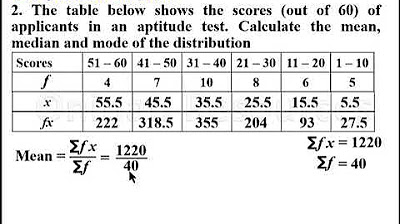How to Find the Precise Median (Interpolated Median)
TLDRIn this educational video, Michael Corayer explains the concept of calculating the interpolated median for continuous variables with large datasets. He illustrates the process with an example, showing that the median isn't always the average of the two middle scores, especially when there are multiple repeated scores. Corayer visually demonstrates how to find the precise median by dividing the 'class interval' and using a formula to interpolate between known values. The video aims to provide clarity on a nuanced statistical method, useful for psychology students and researchers dealing with extensive datasets.
Takeaways
- 📚 The video discusses a precise method for calculating the median for continuous variables with large data sets and repeated scores near the median.
- 🔍 The simple median calculation method, taking the mean of the two middle scores, may not be accurate for continuous variables with many repeated scores.
- 📈 The concept of the median is to find the exact middle point where 50% of scores are below and 50% are above.
- 📊 The video uses an example with scores of 3, 4, 5, 6 (repeated four times), and 8 to illustrate the need for a more precise median calculation.
- 📝 The simple median method would incorrectly give a median of 6 for the given example, but the precise median is actually between 5 and 6.
- 📉 Visualization of the data can help understand the concept of the median, with blocks representing scores and the median as the dividing point.
- 🔢 The class interval, the range of possible values between whole numbers, is important in determining the precise median.
- 🔑 The precise median is found by taking a portion of the scores at the repeated value, in this case, a quarter of the scores at 6, to balance the data around the median.
- ➗ The interpolated median is calculated by adding a fraction of the class interval to the lower limit of the median, resulting in a more accurate value.
- 📘 The formula for the interpolated median is derived from the example, involving the lower limit of the median, the number of scores, and the class interval.
- 🛠 While the formula is useful for understanding the concept, it is typically used in software for large datasets rather than manual calculation.
Q & A
What is the main topic of the video script by Michael Corayer?
-The main topic of the video script is the concept of calculating a more precise median for continuous variables with large data sets, especially when there are many repeated scores near the median.
Why is the simple median method not always accurate for continuous variables?
-The simple median method may not be accurate for continuous variables because it only takes the mean of the two middle scores, which can be misleading when there are many repeated scores near the median, thus not reflecting the precise middle point of the data.
What is the term used for the method of finding the precise middle point of data for continuous variables?
-The term used for finding the precise middle point of data for continuous variables is the interpolated median.
What is an example of a continuous variable mentioned in the script?
-An example of a continuous variable mentioned in the script is time measured in seconds, which can be divided into infinite decimal places.
What is a class interval in the context of the script?
-A class interval, in the context of the script, refers to the range of values that a score can take within a certain whole number, such as from 4.5 up to 5.5 for a score of 5 seconds.
How does the script suggest visualizing the data to find the precise median?
-The script suggests visualizing the data by drawing a line representing the scores and using blocks to represent each participant's score, allowing one to see where 50% of the scores are below and above, and thus find the precise median.
What is the formula for calculating the interpolated median as described in the script?
-The formula for calculating the interpolated median is the lower limit of the median (L) plus the fractional portion, which is (n/2 - frequency of scores below the lower limit of the median) divided by the frequency of scores at the median (f of m), multiplied by the class interval (h).
Why might one need to calculate the interpolated median in a large data set?
-One might need to calculate the interpolated median in a large data set because with hundreds or thousands of scores stacked up at the median, a slight over or underestimate of the median could significantly impact the analysis.
What is the purpose of the interpolated median in statistical analysis?
-The purpose of the interpolated median in statistical analysis is to provide a more accurate measure of central tendency for continuous variables with many repeated scores, ensuring that the median reflects the true middle point of the data.
Why is it suggested that one might not need to calculate the interpolated median by hand for most samples?
-It is suggested that one might not need to calculate the interpolated median by hand for most samples because with smaller samples, a slight over or underestimate of the median won't significantly affect the results, making manual calculation unnecessary.
How can one better understand the concept of the interpolated median if they are using software?
-One can better understand the concept of the interpolated median if they are using software by having a clear understanding of where the interpolated value is coming from, which the script explains through the example and the formula.
Outlines
📊 Understanding the Concept of Median for Continuous Variables
Michael Corayer introduces the concept of calculating the median for continuous variables with a more precise method than the traditional mean of the middle two scores. He explains that this is especially relevant for large datasets with many repeated scores near the median, which can skew the central tendency. Using an example with eight participants and their scores, he illustrates the discrepancy between the simple median method and the actual median. He then suggests visualizing the data to find the precise median point, where 50% of scores lie on either side, and introduces the concept of class interval to determine the exact median value.
📐 Deriving the Formula for the Interpolated Median
Continuing from the previous explanation, Corayer delves into the derivation of a formula to calculate the interpolated median, which is necessary for large datasets with many scores clustered at the median. He uses the example of scores clustered at 6 seconds to demonstrate how to find the precise median by considering the class interval and the frequency of scores at the median. The formula he derives involves the lower limit of the median, the fractional portion of the scores needed to reach the midpoint, the frequency of scores at the median, and the class interval. This formula allows for a more accurate calculation of the median, especially in large datasets where a visual approach would be impractical.
Mindmap
Keywords
💡Central Tendency
💡Median
💡Continuous Variable
💡Class Interval
💡Interpolated Median
💡Fractional Portion
💡Frequency
💡Data Visualization
💡Formula
💡Psychology Tutorials
Highlights
A more precise method for calculating the median for large datasets of a continuous variable is introduced.
Traditional median calculation may not be accurate when there are many repeated scores near the median.
Continuous variables can be divided into infinite fractional parts, which is crucial for precise median calculation.
An example with scores 3, 4, 5, 6, 6, 6, 6, 6, and 8 is used to demonstrate the concept.
The simple median method might not reflect the precise middle point of the data.
Visualizing data with a line and blocks representing scores helps in understanding the precise median.
The median should be where 50% of scores are below and 50% are above, not just the mean of the middle scores.
The concept of class interval is introduced, which is the range a score could theoretically occupy.
The precise median is found to be between 5.5 and 6 seconds, not exactly at 6.
Interpolated median is a value found between known values, in this case, between 5 and 6 seconds.
A formula for calculating the interpolated median is derived from the example.
The formula involves the lower limit of the median, the class interval, and the frequency of scores.
The interpolated median is calculated as 5.75 seconds in the example.
Interpolated median is particularly useful for large datasets with many scores at the median.
Software can be used to calculate the interpolated median, but understanding the formula is important.
The video provides a clear explanation of the concept and calculation of the interpolated median.
Transcripts
Browse More Related Video
5.0 / 5 (0 votes)
Thanks for rating:





